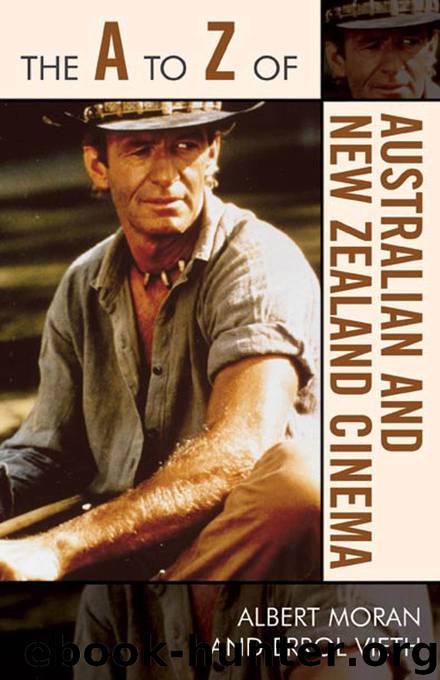The A to Z of Australian and New Zealand Cinema by Albert Moran & Errol Vieth

Author:Albert Moran & Errol Vieth
Language: eng
Format: epub
Publisher: Scarecrow Press
Published: 2009-03-14T16:00:00+00:00
– N –
NATIONAL IDENTITY. The idea of a national identity is as problematic as the idea of a nation. A nation is a changing semiosphere of influences and emerging tendencies, rather than a permanent, fixed entity waiting to be discovered, analyzed, and classified. National identity is a question, not an answer, depending on the context in which the question is asked and the contemporary cultures that, in a sense, only become real when certain elements in the semiosphere are identified, and concretized.
In Australia, a separate national identity became an issue over a period of time, when the notion of “an Australian” became important because what had gone before was no longer adequate. Through changes in global politics and economics, Australia in the late 1960s and 1970s was forced to question its position in the world, possibly because of changes forced on the nation through its involvement in Vietnam, but also because of the changes in market structures that occurred in Europe and effectively closed the European market to Australian primary products. The nation had to develop new markets in the booming Japanese economy, as well as in other Southeast Asian nations. For whatever reason though, conscious affirmations of Australian identity appeared on theater screens, as a direct consequence of the newly state-supported film industry in the 1970s (see REVIVAL). In retrospect, any kind of uniform national identity was problematic and always open to question and revision. Australian national identity first seemed to be masculine, coarse, vulgar, and anti-intellectual (see OCKER FILMS). Missing in this cycle were representations of women as the focus or driver of the narrative. This was rectified in some films of the subsequent cycle, where filmmakers focused on women in films like Picnic at Hanging Rock (1975), but those representations were hardly iconic (see ART AND PERIOD FILMS). Outside that genre, the peculiarities of growing up for some teenage girls in a certain Australian culture was the subject of Bruce Beresford’s Puberty Blues (1981). Also outside both these genres was the forerunner to Mad Max (1979), Stone (1974), where the national identity propounded by the ocker films was seriously questioned, replacing it with a considered and defiant outlaw who was alienated from mainstream society. Max Rockatansky is also alienated in a world that is Australian, but which could just as easily have been the American Midwest. Thus the notion of Australian identity becomes blurred with global, Western-culture identities.
Certainly, since Mad Max, many films have focused on unique Australian situations created by unique Australian characters. Muriel’s Wedding (1994), Mullet (2001), The Sum of Us (1994), and Strictly Ballroom (1992) are populated by characters who are recognizably Australian, but who do not define what it is to be Australian. Thus, any description of national identity is now a plurality of possibilities, a panoply of potentialities, rather than a distinct type imbued with specific qualities. Characters are more obviously human (or not), even when they are also Australian. Only in such a world is it possible to have The Adventures of Priscilla (1994), with three strange Australians traveling among other strange Australians.
Download
This site does not store any files on its server. We only index and link to content provided by other sites. Please contact the content providers to delete copyright contents if any and email us, we'll remove relevant links or contents immediately.
Call Me by Your Name by André Aciman(20371)
Ready Player One by Cline Ernest(14524)
How to Be a Bawse: A Guide to Conquering Life by Lilly Singh(7391)
Wiseguy by Nicholas Pileggi(5671)
The Kite Runner by Khaled Hosseini(5083)
On Writing A Memoir of the Craft by Stephen King(4863)
Audition by Ryu Murakami(4850)
The Crown by Robert Lacey(4723)
Call me by your name by Andre Aciman(4619)
Gerald's Game by Stephen King(4581)
Harry Potter and the Cursed Child: The Journey by Harry Potter Theatrical Productions(4440)
Dialogue by Robert McKee(4321)
The Perils of Being Moderately Famous by Soha Ali Khan(4169)
Dynamic Alignment Through Imagery by Eric Franklin(4116)
Apollo 8 by Jeffrey Kluger(3637)
Seriously... I'm Kidding by Ellen DeGeneres(3577)
The Inner Game of Tennis by W. Timothy Gallwey(3575)
How to be Champion: My Autobiography by Sarah Millican(3555)
Darker by E L James(3477)
